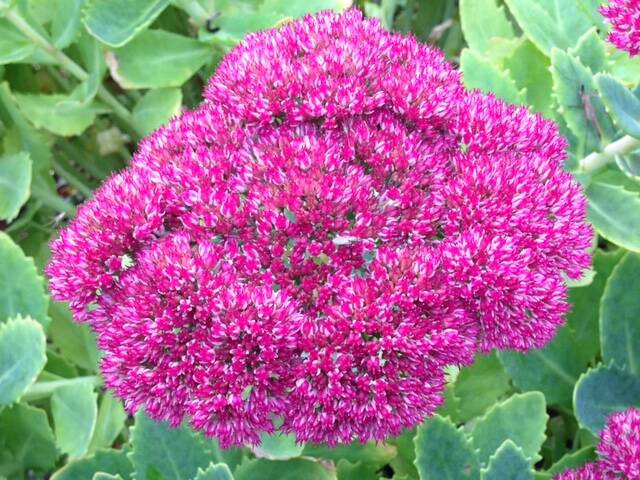Succulents are beautiful, often exotic looking plants that many may think are not viable perennials in the Pacific Northwest (PNW) climate.
However, they are determined adaptors that are fun and sometimes challenging to grow. In fact, there are beautiful succulents, native and non-native to the PNW, waiting to thrive and make a statement in your garden.
The hardy and native succulent Lewisia cotyledon can be found in the Olympic National Park as well as local nurseries. It is an evergreen perennial of incredible beauty and well-balanced proportions. Fleshy leaves emerge in flat rosettes of spoon-shaped dark green leaves. Funnel-shaped flowers to 1 inch across are borne in compact panicles. The true species has candy-striped pink flowers. Hybrids bloom all sorts of colors.
Several varieties of tough sedums (a.k.a. stonecrop) are native, including the hardy S. spathulifolium “Cape Blanco,” found hanging from the cliffs at Salt Creek. This ground-hugging evergreen beauty has powder-blue and pewter foliage which, in midsummer, is topped by heads of yellow flowers. In winter the foliage displays a more greenish color, often with red and purple highlights. It’s perfect for a dry spot or crevice garden.
And if you are into cactus, Opuntia fragilis (brittle prickly-pear cactus) is a native, hiding in the low brush of the National Forest. O. fragilis is the smallest and most cold hardy of all the opuntia, or prickly-pears. While perhaps not considered beautiful, its prickly ground hugging form, with 1-2 inch long and wide connected pads, is unique. This is not a plant for a garden with children, or careless gardeners, as the barbed spines are painful.
Hardy, non-native succulents that compliment native plantings are numerous and found in many garden stores and at plant sales.
There is an abundance of fascinating hardy plants from the genus Sempervivum (Hen and Chicks). They are beautiful outdoor succulents grown for their exotic appearance and resilient nature.
Most varieties resemble an unfurled rose and come in many colors, from burgundy and bright green, to a bluish-gray. They form dense mats that will survive droughts, deep freezes and poor soil. Sempervivum grow easily and will brighten any planting, in a pot or in the ground, with eye-catching forms and textures.
Sedums top the list as some of the easiest of the hardy succulents to grow, sometimes too easy, many of these plants can spread and become invasive. The list of fantastic sedums is long.
Sedum rupestre “Angelina” with its sprawling bright yellow-green summer foliage takes on a copper-orange hue in winter. A vibrant evergreen, it will grow anywhere, sun, shade or pots. While it does tend to spread, it can be forgiven because it is so cheerful and also easy to remove. Two other favorites are S. oreganum, with its glossy green rosettes tipped red and yellow summer flowers and S. tetractinum “Coral Reef,” with a more upright growth and corral tinged foliage if grown in full sun.
Delosperma is a succulent ice plant, hardy to zone 5. D. nubigenum is a variety that grows the best in the PNW climate. It forms a beautiful green low mat with long blooming yellow flowers. D. cooperi has slightly larger foliage but with striking red, orange or bright pink flowers. Neither type likes our wet winter but can survive with a little care (gravel mulch). Both flower best in full-sun and need well-drained soil.
The possibilities go on; a few species of Agave and Yucca are hardy enough for lower elevations and make a big statement in the succulent garden. A less common plant Rosularia platyphylla grows in a dense mat of rosettes and is worth the effort to find, perhaps online.
One thing that is true for almost all succulent plants is that they need extremely well-draining soils. Incorporating grit and sharp sand in the soil mix works well. Grit, sand or pebbles can also be used as mulch (important in winter), to keep the foliage away from wet soil.
The process of choosing succulents for your landscape or containers is exactly the same as choosing any other plant, research. The more you know about the cultural requirements of plants, the more successful you will be.
Be aware, some garden centers may have hardy succulents for sale alongside tender succulents. These tender succulents are suitable for annual outdoor use but need to be brought indoors for winter.
Thanks for the support
A heartfelt thank you to the community for supporting the 2023 Master Gardener Spring Plant Sale! It was a huge success and a fun day. Your support keeps our programs running!
Come visit Woodcock Demonstration Garden, 2711 Woodcock Road, anytime to see your support in action.
Susan Kalmar is a Clallam County Master Gardener with a passion for succulent plants.
Complimentary plantings
In a low-water garden, compliment succulents with perennial plants that prefer dry conditions. Among the best for the Pacific Northwest are saxifrage, lavender, rosemary, sage, artemisia, yarrow, yucca and thyme. Incorporating these plants will add texture and interest to any garden design.


